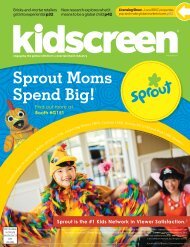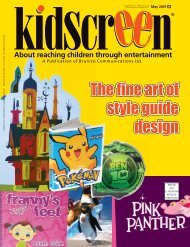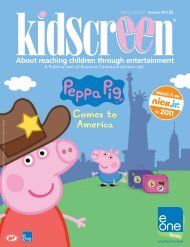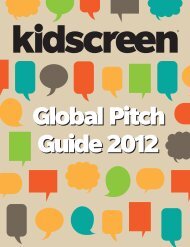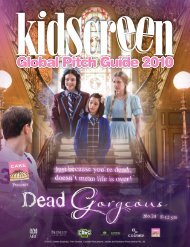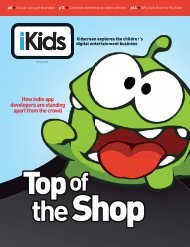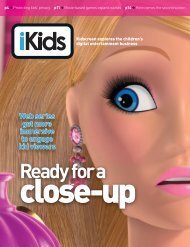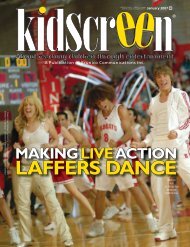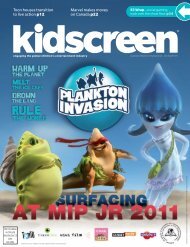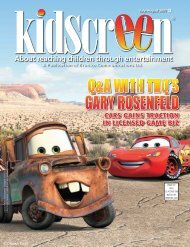rs ANIMATION SECIVRES CONTENTS - Kidscreen
rs ANIMATION SECIVRES CONTENTS - Kidscreen
rs ANIMATION SECIVRES CONTENTS - Kidscreen
You also want an ePaper? Increase the reach of your titles
YUMPU automatically turns print PDFs into web optimized ePapers that Google loves.
According to Pete Denomme, CEO and executive producer<br />
at Yowza, the difference is substantial and has relegated the<br />
traditional hand-drawn technique to a few speciality features.<br />
“With hand-drawing, if you get 30 seconds a week from an<br />
animator you would be very lucky,” says Denomme. “Now you<br />
can get one to two minutes a week per animator.”<br />
Currently, even when a project strives to mine the nostalgic<br />
look of traditional hand-drawn animation, the economic<br />
benefi ts of using a software suite cannot be ignored.<br />
A case in point is Winnie the Pooh, a feature fi lm produced by<br />
Walt Disney Animation Studio and released in July 2011. The studio<br />
decided to use a hybrid of traditional hand-drawn animation<br />
and computer animation produced using Toon Boom’s Harmony<br />
suite. The results, according to Denomme, who has intimate<br />
knowledge of the production, showed that the new technology is<br />
essentially indistinguishable from the traditional animation. “You<br />
couldn’t pick out which parts were hand-drawn and which were<br />
computer-rendered,” he says. “That is why I think that Disney<br />
would do the next one fully in Harmony.”<br />
Another aspect that has helped the spread of Toon Boom’s<br />
Harmony as a major player in the production of 2D animation<br />
is the company’s approach to development. “It’s a very close<br />
relationship,” says Walker. “Toon Boom is driven by the industry.<br />
It is constantly working with produce<strong>rs</strong> to develop new<br />
tools. It’s not like they’re developed in a vacuum; there is a<br />
constant give and take.”<br />
By Gary Rusak<br />
2D<br />
Montreal, Canada-based Toon Boom Animation’s software is leading the charge in creating paperless 2D workfl ows<br />
The close relationship between Toon Boom and its clients<br />
has been a key component in developing innovations that<br />
have spurred more effi ciencies in tools that allow animato<strong>rs</strong><br />
to change characte<strong>rs</strong>, deform drawings and alter things like<br />
color palettes and line width with a simple key stroke.<br />
The next innovations from Toon Boom, according to Vogelesang,<br />
will mirror the world of computing in general with a<br />
bigger reliance on cloud computing and the integration of<br />
iPad and Android tablets into the pipeline.”It’s not standing<br />
still at all,” she says. “It’s moving forward because the demand<br />
is moving forward.”<br />
With a cost on the lower end ranging from US$200,000<br />
to US$250,000 for a 22-minute ep, 2D comes in about<br />
US$100,000 cheaper than its CGI counterpart. But produce<strong>rs</strong><br />
agree that saving money is not a good enough reason to<br />
chose one format over another.<br />
“You have to look at what is good for the project and then<br />
think about budget concerns,” says Julie Stall, VP of production<br />
at Toronto, Canada-based Portfolio Entertainment.<br />
It’s a familiar concept for Yowza’s Denomme. “These are all<br />
techniques to tell a particular story,” he says. “Some concepts<br />
don’t work for 3D and some don’t work for 2D. Everything<br />
starts on paper and from there we decide what method will be<br />
best to tell the story we want to tell.”<br />
However, there are a few axioms that hold true. For instance,<br />
the traditional 2D look seems to work well for a certain<br />
KIDSCREEN’S <strong>ANIMATION</strong> SERVICES ISSUE 2012<br />
21



